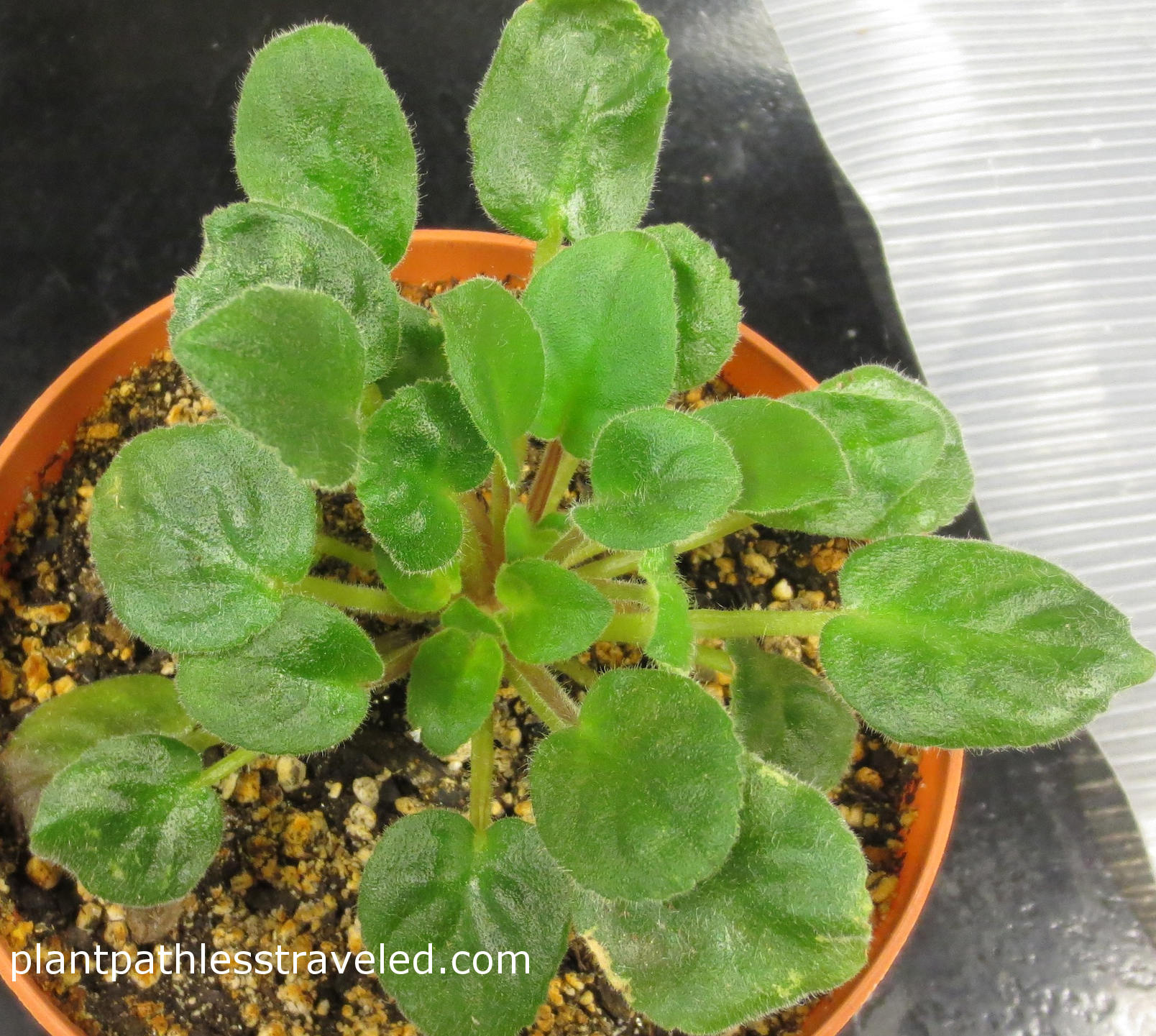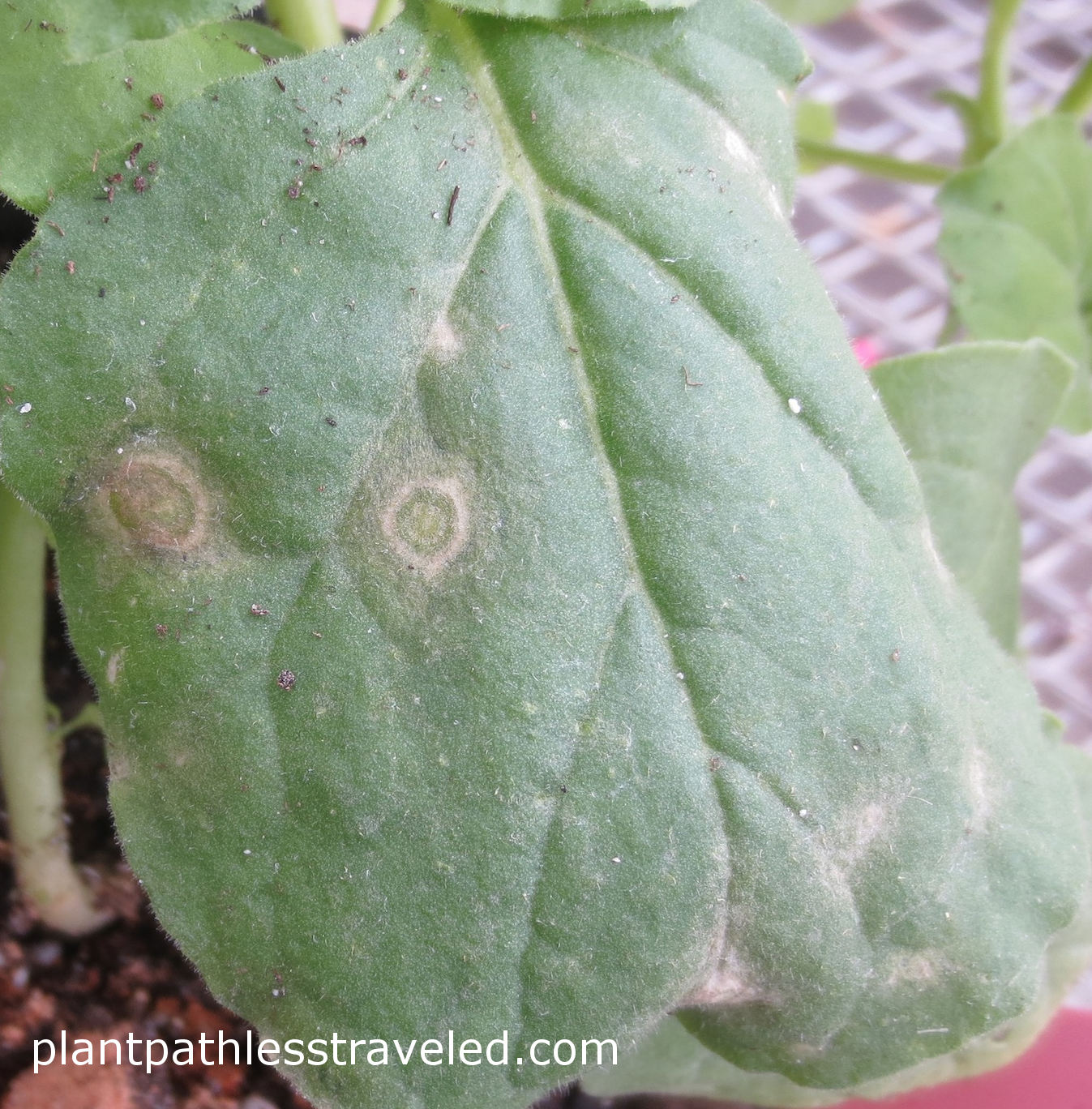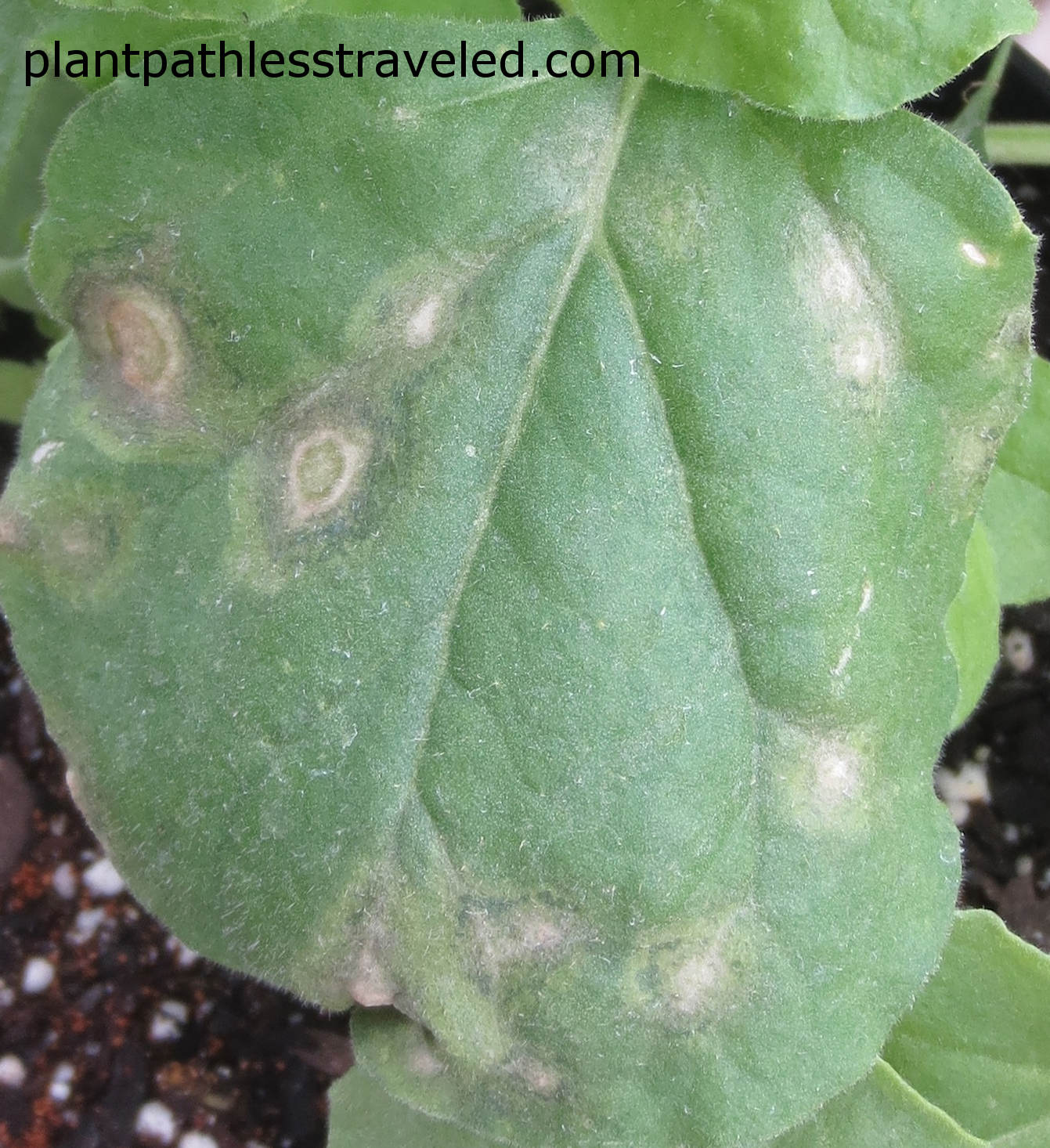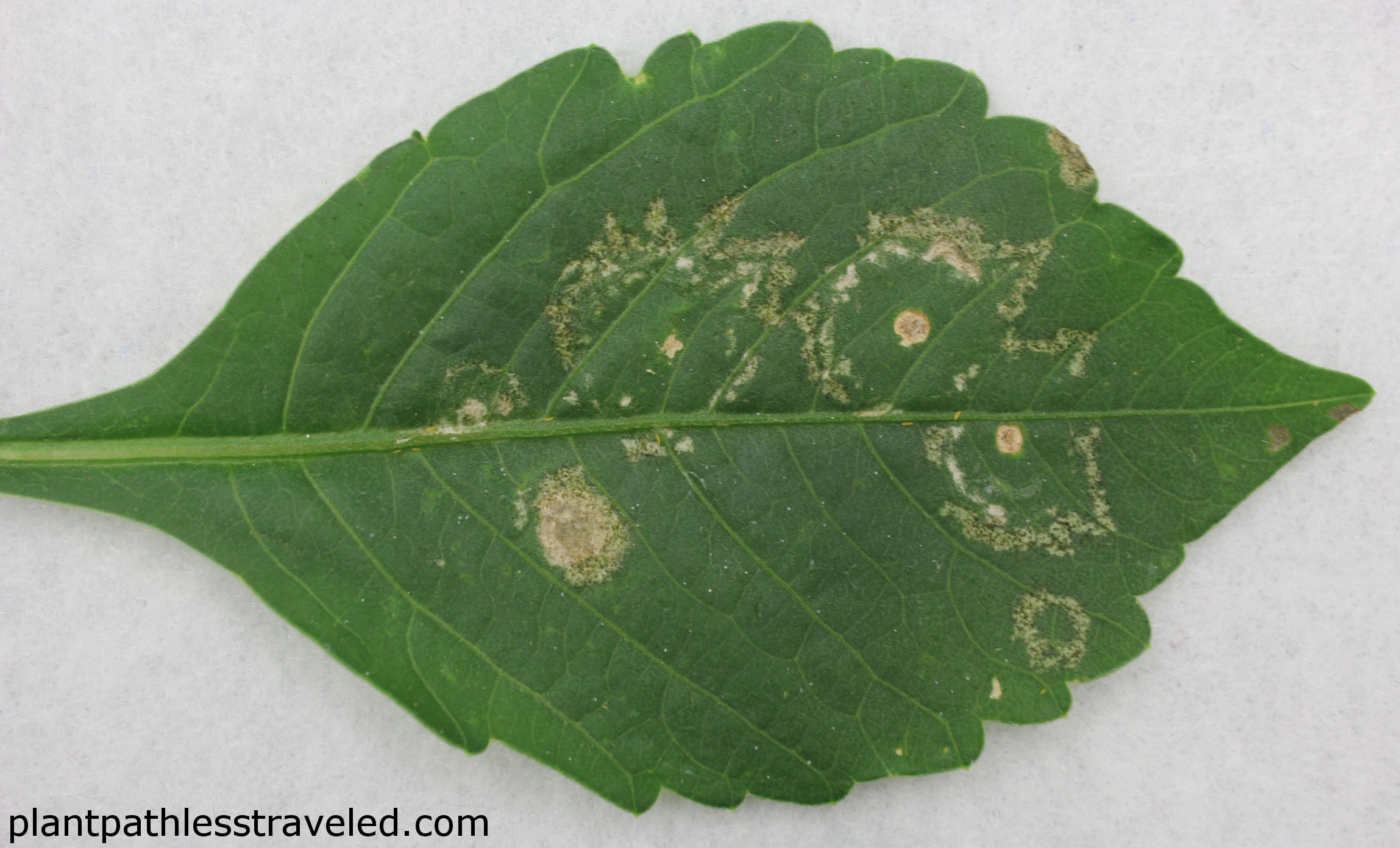Impatiens Necrotic Spot Virus
Impatiens necrotic spot virus (INSV) is a common plant virus found throughout the world. INSV causes a wide variety of symptoms and is named after the characteristic necrotic spots and rings formed by some plant species infected with this virus. INSV can be difficult to manage because it is spread by thrips. Investing in virus free propagating material, monitoring and managing thrip levels, and testing and destroying infected plants are key to control this virus in plant production facilities.
Introduction
Impatiens necrotic spot virus (abbreviated INSV) is a prevalent plant virus found in horticultural production facilities. INSV was originally described as a strain of Tomato spotted wilt virus (TSWV) and was called the Tomato spotted wilt virus-Impatiens strain (TSWV-I) (Law & Moyer 1990). This name is rarely used today but can be observed in literature prior to the early 1990's.
Differences in TSWV strains were first reported in 1955 (Best & Gallus 1955). INSV responded weakly or not at all with antiserum to TSWV (Law & Moyer 1990; Wang & Gonsalves 1990). In addition, distinct structures could be seen in thin sections of plants infected with INSV but not TSWV (Law & Moyer 1990, Urban et al. 1991). This data drove the research that characterized INSV and today allows it to be detected separately from TSWV.
INSV is classified in the genus Tospovirus and has a single stranded RNA genome consisting of three segments. These segments are packaged into quasi-spherical particles (Law & Moyer 1991).
Symptoms
The symptoms caused by INSV vary widely and range from purple spots, necrotic (dying) spots, stunting, yellow concentric rings, wilting, stem lesions, plant death, and others. Some plants can exhibit no symptoms of INSV infection (they are asymptomatic). Asymptomatic plants can act as a virus reservoir where thrip vectors can acquire it. INSV symptoms can vary based on plant age when infected, growth conditions, plant growth rate, plant species/cultivar, and more.

Symptoms can be easily attributed to nutrient, chemical, environmental issues or confused with fungal or bacterial pathogens.
INSV has been found in over 350 species of plants including ornamental bedding plants, vegetables, weeds, and field crops originating from greenhouse transplants that were contaminated (Daughtrey et al. 1997).
Uneven symptom distribution among plants could be attributed to thrip feeding patterns. There have been no extensive surveys published since 1997 on the prevalence of INSV in horticulture of vegetable crops in the US (Daughtrey et al. 1997).
 INSV symptoms in Nicotiana benthamiana. Note the characteristic necrotic rings formed where a thrip vector carrying INSV fed.
INSV symptoms in Nicotiana benthamiana. Note the characteristic necrotic rings formed where a thrip vector carrying INSV fed.


The Vector
INSV is primarily spread by thrips. The most prevalent INSV thrip vector in the USA is the western flower thrip, Frankliniella occidentalis (Van De Wetering et al 1996). Adult thrips are 1 mm in size and can be difficult to detect. Western flower thrip larva acquire INSV and can transmit the virus through their adult life (Van De Wetering et al 1996).
INSV can also be transmitted mechanically but this is not the prevalent route of spread in horticultural production facilities (Daughtrey et al. 1997).
Control
The best defense against INSV is to invest in virus free propagating material. Any new plants brought into the production facility should be inspected closely for symptoms of viral pathogens or thrip vectors. New plants should be isolated until they are verified to be INSV and thrip free. Thrip populations can be monitored with blue sticky traps placed at plant height. High thrip populations can be managed through use of insecticides but care must be taken to properly apply them due to the fact that thrips prefer to hide inside flowers and leaf buds. Insecticides should also be rotated to decrease the risk of allowing insects to become resistant to them as some thrip populations are already resistant to various chemicals (Daughtrey et al. 1997).
It is important to remember that even if thrips are present, if the plants are free from virus no losses will be attributed to INSV.
Transgenic crops were developed in the 1990's to resist INSV (and other Tospoviruses) but they have not been utilized (Gonsalves et al. 1995).
Testing
INSV can be detected through the use of immuno-strips in the field. These can be purchased directly by growers or plants can be submitted to a local plant disease clinic for testing. Symptomatic tissue should be used for testing.
INSV can also be detected through the use of indicator plants such as Nicotiana benthamiana, Petunia hybrida, and dwarf fava bean (Daughtrey et al. 1997).
All photos were taken by Sara Bratsch, for non commercial use only.
Please contact regarding all other uses.
Cite this article:
Bratsch, Sara. “Impatiens Necrotic Spot Virus” Web Article. 31 May 2016. http://plantpathlesstraveled.com/impatiensnecroticspotvirus/
Citations
Avila, A. D., Haan, P. D., Kitajima, E. W., Kormelink, R., Resende, R. D. O., Goldbach, R. W., & Peters, D. (1992). Characterization of a Distinct Isolate of Tomato Spotted Wilt Virus (TSWV) from Impatiens sp. in The Netherlands. Journal of Phytopathology, 134(2), 133-151.
Best, R.J. & Gallus, H.P. (1955). Strains of tomato spotted wilt virus. Australian Journal of Science. 15, 212-214.
Daughtrey, M. L., Jones, R. K., Moyer, J. W., Daub, M. E., & Baker, J. R. (1997). Tospoviruses strike the greenhouse industry: INSV has become a major pathogen on flower crops. Plant Disease, 81(11), 1220-1230.
de Haan, P., de Avila, A. C., Kormelink, R., Westerbroek, A., Gielen, J. J., Peters, D., & Goldbach, R. (1992). The nucleotide sequence of the S RNA of Impatiens necrotic spot virus, a novel tospovirus. FEBS letters, 306(1), 27-32.
Gonsalves, D., Pang, S. Z., Gonsalves, C., Xue, B., Yepes, M., & Jan, F. J. (1995). Developing transgenic crops that are resistant to tospoviruses. Tospoviruses and Thrips of Floral and Vegetable Crops 431, 427-431.
Law, M. D., & Moyer, J. W. (1990). A tomato spotted wilt-like virus with a serologically distinct N protein. Journal of General Virology, 71(4), 933-938.
Law, M. D., Speck, J., & Moyer, J. W. (1991). Nucleotide sequence of the 3? non-coding region and N gene of the S RNA of a serologically distinct tospovirus. Journal of General Virology, 72(10), 2597-2601.
Law, M. D., Speck, J., & Moyer, J. W. (1992). The M RNA of impatiens necrotic spot Tospovirus (Bunyaviridae) has an ambisense genomic organization. Virology, 188(2), 732-741.
Urban, L. A., Huang, P. Y., & Moyer, J. W. (1991). Cytoplasmic inclusions in cells infected with isolates of L and I serogroups of tomato spotted wilt virus. Phytopathology, 81(5), 525-529.
Van De Wetering, F., Goldbach, R., & Peters, D. (1996). Tomato spotted wilt tospovirus ingestion by first instar larvae of Frankliniella occidentalis is a prerequisite for transmission. PHYTOPATHOLOGY-NEW YORK AND BALTIMORE THEN ST PAUL-, 86, 900-905.
Wang, M., & Gonsalves, D. (1990). ELISA detection of various tomato spotted wilt virus isolates using specific antisera to structural proteins of the virus. Plant Disease, 74(2), 154-158.